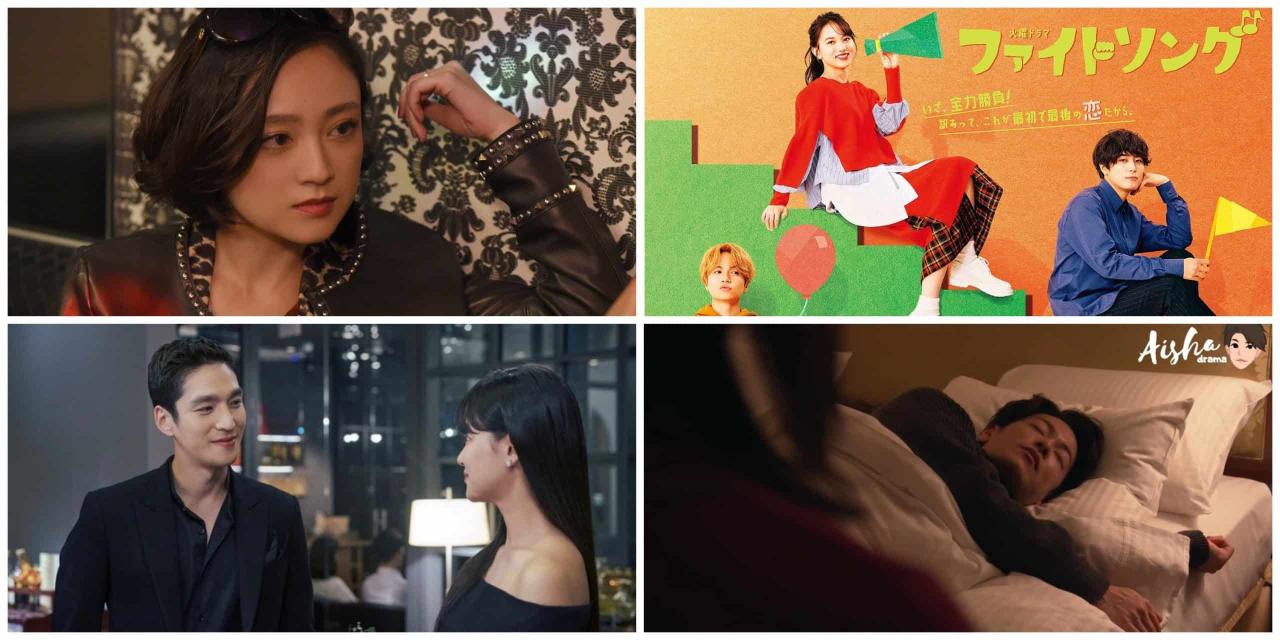Intense 21+ Romantic Dramas explore the complexities of adult relationships, delving into themes of forbidden love, societal pressures, and power dynamics. These dramas often feature compelling character archetypes grappling with internal conflicts and external obstacles, creating narratives filled with suspense, emotional depth, and captivating storytelling. The use of visual elements, music, and carefully crafted pacing enhances the emotional impact, leaving a lasting impression on the viewer.
This exploration examines the defining characteristics of intense romantic dramas, analyzing prevalent themes, character archetypes, narrative structures, and the impact of visual storytelling. We’ll delve into the complexities of relationship dynamics, the emotional manipulation employed to engage the audience, and the cultural reflections embedded within these narratives. Finally, we’ll look at notable examples and speculate on future trends within this compelling genre.
Defining “Intense 21+ Romantic Drama”
The term “intense 21+ romantic drama” denotes a specific subgenre of romantic films and television shows characterized by heightened emotional stakes, mature themes, and complex character relationships. The “21+” designation signifies content that is unsuitable for younger audiences due to the inclusion of mature themes, such as explicit sexual content, graphic violence, or depictions of morally ambiguous situations. The intensity stems from the dramatic conflicts and emotional depth explored within the romantic narrative.
The key elements differentiating intense romantic dramas from milder ones lie in the exploration of mature and complex themes. Milder romantic dramas often focus on the initial stages of courtship, emphasizing lightheartedness and predictable resolutions. In contrast, intense romantic dramas delve into the complexities of long-term relationships, exploring themes such as infidelity, betrayal, loss, grief, and the lasting impact of past traumas on present relationships. The emotional journeys of the characters are deeply explored, often resulting in morally grey areas and challenging the viewers’ perspectives. The pacing is generally faster, with heightened tension and conflict driving the narrative forward.
Mature Themes and Content
Intense 21+ romantic dramas often feature explicit sexual content, which is absent or heavily implied in milder versions. The depiction of intimacy is not merely for titillation but rather a tool to showcase the emotional connection and vulnerability between the characters, or conversely, the lack thereof. Furthermore, these dramas may portray violence, either directly impacting the relationship or stemming from external conflicts that affect the characters’ emotional landscape. This could involve physical violence, psychological manipulation, or even the depiction of traumatic events that shape the characters’ actions and choices within the romantic context. The exploration of these mature themes necessitates a higher age rating, reflecting the complexity and potential emotional impact on viewers. For example, a film like “Blue Valentine” showcases the deterioration of a marriage through realistic and often painful depictions of infidelity and emotional abuse. In contrast, a milder romantic drama might focus on the initial spark and courtship, avoiding the complexities of a long-term relationship’s potential struggles.
Character Development and Relationship Dynamics
The characters in intense romantic dramas are typically multifaceted and morally ambiguous. They are not simply “good” or “bad,” but possess flaws and make mistakes that impact their relationships. This contrasts with milder romantic dramas, where characters are often more idealized and their conflicts more easily resolved. The relationships themselves are complex and often fraught with challenges. These challenges go beyond simple misunderstandings, exploring deeper issues of trust, commitment, and self-discovery. The emotional arc of the relationship is often non-linear, with significant highs and lows that reflect the realities of long-term romantic partnerships. A film like “Marriage Story” provides a compelling example of this, showcasing the intricate emotional turmoil and legal battles involved in a dissolving marriage, revealing the vulnerabilities and flaws of both partners.
Narrative Structure and Pacing
Intense romantic dramas often employ a more unpredictable and less formulaic narrative structure compared to their milder counterparts. The pacing is frequently faster, building suspense and tension through escalating conflicts and unexpected plot twists. Happy endings are not guaranteed, and the narrative may conclude on an ambiguous note, reflecting the complexities of real-life relationships. The focus is less on a neat resolution and more on the emotional journey of the characters and the impact of their experiences. This contrasts with milder romantic dramas, which often follow a more predictable structure, culminating in a clear and satisfying resolution. For instance, the film “Brokeback Mountain” masterfully depicts a forbidden and ultimately tragic love story, avoiding a conventional happy ending but offering a powerful exploration of the characters’ emotional journey.
Themes and Tropes in Intense Romantic Dramas: Intense 21+ Romantic Dramas
Intense 21+ romantic dramas often delve into complex emotional landscapes, exploring themes that resonate deeply with audiences. These narratives frequently utilize established tropes to heighten the dramatic tension and emotional impact of the central romantic relationship. The exploration of these themes and tropes is what elevates these dramas beyond simple love stories and into compelling explorations of human connection and conflict.
Intense romantic dramas frequently utilize several recurring themes. These themes, often intertwined and overlapping, contribute to the overall narrative intensity.
Prevalent Themes in Intense Romantic Dramas
Five prevalent themes explored in intense 21+ romantic dramas are forbidden love, societal pressures, overcoming obstacles, passion versus commitment, and the exploration of power dynamics. These themes often create conflict and tension, driving the narrative forward and providing opportunities for character development and emotional exploration. The intensity of the drama often stems from the characters’ struggles to navigate these complex themes within the context of their relationship.
Forbidden Love as a Central Theme
Forbidden love serves as a potent catalyst for conflict and drama in intense romantic narratives. This theme often involves relationships that are socially unacceptable, perhaps due to significant age gaps, pre-existing commitments, or family disapproval. The inherent risk and the societal repercussions associated with such relationships intensify the emotional stakes. The characters’ defiance of societal norms and their willingness to fight for their love contribute to the drama’s intensity. For example, a story about a teacher falling in love with a student immediately establishes a forbidden relationship, creating inherent tension and conflict. The potential for scandal, loss of reputation, and legal repercussions significantly raises the stakes.
Societal Pressures in Intense Romantic Relationships
Societal pressures are frequently portrayed as significant obstacles in intense romantic dramas. These pressures can manifest in various ways, including family disapproval, social stigma, and cultural expectations. The characters’ struggles to reconcile their desires with societal expectations create internal conflict and external pressures. For example, a drama might depict a couple from different social classes facing disapproval from their families and friends, leading to secret meetings and strained relationships. Another example could be a same-sex couple navigating societal homophobia and fighting for the right to love openly. The portrayal of these struggles can resonate with audiences who have experienced similar challenges in their own lives.
Character Archetypes

Intense romantic dramas thrive on compelling characters, often employing established archetypes to explore complex relationships and emotional turmoil. These archetypes, while familiar, are rarely simple; they possess nuanced motivations and internal conflicts that drive the narrative forward and resonate with audiences. Understanding these archetypes provides a framework for analyzing the dramatic tension and emotional depth within these films.
Common Male Character Archetypes
The following profiles detail three frequently encountered male archetypes in intense romantic dramas, highlighting their defining traits, motivations, and internal struggles.
The Brooding Anti-Hero: This character is often emotionally guarded, possessing a troubled past or a dark secret that makes him initially unapproachable. His cynicism and rebellious nature mask a deep-seated vulnerability and capacity for love. His motivation is often self-preservation, stemming from past trauma, but he is drawn to the heroine despite his attempts to resist. Internal conflict arises from his fear of intimacy and his struggle to reconcile his past with his present desires. Examples include Edward Cullen from *Twilight* (though arguably bordering on the Byronic hero) or Christian Grey from *Fifty Shades of Grey*.
The Charming Rake: This archetype is outwardly charismatic and confident, often using his charm and wit to manipulate situations and relationships to his advantage. His motivation is primarily self-gratification, often seeking conquest rather than genuine connection. However, a genuine connection with the heroine often forces him to confront his superficiality and confront the emptiness behind his conquests. The internal conflict arises from his struggle between his hedonistic lifestyle and the unexpected depth of his feelings for the heroine. Think of characters like Mr. Darcy in early adaptations of *Pride and Prejudice* (though later adaptations often soften this portrayal) or some interpretations of Rhett Butler from *Gone With the Wind*.
The Dedicated Protector: This character is selfless and deeply committed to the heroine’s well-being. His motivation is driven by a strong sense of duty and loyalty, often stemming from a profound love and desire to protect the heroine from harm. His internal conflict might arise from his inability to express his feelings openly or his struggle to balance his protective instincts with the heroine’s need for independence. Examples can be found in many classic romances, such as the steadfast and loyal heroes in numerous historical romances or even the more modern takes on the “knight in shining armor” trope.
Common Female Character Archetypes
Similar to the male counterparts, female archetypes in intense romantic dramas are far from one-dimensional, possessing complex motivations and internal struggles that contribute to the overall narrative arc.
The Independent Rebel: This heroine is fiercely independent, often challenging societal norms and expectations. Her motivation is self-reliance and a desire for autonomy. Internal conflict arises from her fear of vulnerability and her struggle to balance her need for independence with her desire for a meaningful relationship. This archetype is frequently seen in modern romantic dramas where women are breaking away from traditional gender roles. Think of characters like Lisbeth Salander from *The Girl with the Dragon Tattoo* (though the romantic element is secondary) or many female leads in contemporary romances that emphasize female empowerment.
The Vulnerable Innocent: This archetype is often portrayed as naive and trusting, possessing a purity and innocence that contrasts with the harsh realities of the world around her. Her motivation is often a search for love and belonging. Internal conflict arises from her vulnerability and her struggle to navigate complex relationships and overcome obstacles. This is a classic romantic heroine, often seen in period pieces or fantasy settings. Examples can be found in many classic fairytales or historical romances where the damsel is not quite so damseled.
The Strong, Ambitious Woman: This character is driven and ambitious, prioritizing her career or personal goals. Her motivation is self-actualization and a desire to achieve success in her chosen field. Internal conflict arises from her struggle to balance her professional aspirations with her romantic desires, often facing societal pressures and expectations that challenge her ability to achieve both. This archetype reflects modern female characters who navigate the complexities of career and love. Examples are abundant in contemporary romantic comedies and dramas where women excel in their careers while finding love.
Comparative Table of Character Archetypes
| Trait | Brooding Anti-Hero | Charming Rake | Dedicated Protector |
|---|---|---|---|
| Personality | Emotionally guarded, cynical | Charismatic, manipulative | Selfless, loyal |
| Motivation | Self-preservation, overcoming past trauma | Self-gratification, conquest | Protection of heroine, deep love |
| Conflict | Fear of intimacy, reconciling past and present | Superficiality vs. genuine connection | Balancing protection and independence |
| Trait | Independent Rebel | Vulnerable Innocent | Strong, Ambitious Woman |
|---|---|---|---|
| Personality | Fiercely independent, defiant | Naive, trusting | Driven, ambitious |
| Motivation | Self-reliance, autonomy | Love, belonging | Self-actualization, professional success |
| Conflict | Vulnerability vs. independence | Navigating complex relationships | Balancing career and romance |
Narrative Structures and Plot Devices
Intense romantic dramas often employ specific narrative structures and plot devices to maximize emotional impact and keep audiences engaged. The choice of structure and the strategic use of plot twists significantly influence the overall viewing experience, creating a compelling narrative arc that resonates with the audience on a deeply emotional level.
The most common narrative structure is linear, presenting the story chronologically from beginning to end. This allows for a clear understanding of the relationship’s development and the progression of the conflict. However, many intense romantic dramas also utilize non-linear structures, such as flashbacks or parallel storylines, to build suspense and reveal crucial information gradually. This technique can create a sense of mystery and intrigue, adding layers of complexity to the central romance. Non-linear storytelling can also be used to highlight the emotional turmoil of the characters, showcasing the impact of past events on their present relationships.
Plot Twists and Cliffhangers
Plot twists and cliffhangers are essential tools for maintaining tension and captivating the audience in intense romantic dramas. Unexpected revelations, such as a hidden past relationship, a betrayal of trust, or a sudden illness, can dramatically shift the dynamics of the central romance, forcing characters to confront difficult choices and creating significant emotional upheaval for both the characters and the viewers. Cliffhangers, on the other hand, are used to end scenes or episodes on a suspenseful note, leaving the audience eagerly anticipating the resolution. For instance, a cliffhanger might involve a character making a life-altering decision, a dramatic confrontation, or a near-fatal accident, leaving the audience in a state of heightened anticipation. The use of these devices enhances the dramatic intensity and emotional investment of the viewers. A classic example of a plot twist is the revelation of a secret identity in a romantic drama, like a character being secretly married or having a criminal past. This revelation would significantly impact the romantic relationship and create intense conflict. A cliffhanger could be a car crash involving the main characters, leaving their fate uncertain until the next episode.
Pacing and Emotional Impact
Pacing plays a crucial role in determining the emotional impact of an intense romantic drama. Slow pacing can build anticipation and deepen the emotional connection between the characters and the audience, allowing for intimate moments and a gradual exploration of their relationship. Conversely, rapid pacing can create a sense of urgency and heighten the drama, especially during moments of conflict or crisis. The skillful manipulation of pacing allows filmmakers to control the emotional rhythm of the story, maximizing the impact of key scenes and ensuring a satisfying narrative arc. For example, a slow-paced scene showcasing a tender moment between the lovers can be followed by a rapidly paced action sequence where one of them is in danger, creating a powerful contrast that amplifies the emotional intensity. This strategic use of pacing ensures that the audience experiences a rollercoaster of emotions, fully immersing themselves in the dramatic unfolding of the romantic relationship.
Visual Storytelling and Atmosphere
Intense 21+ romantic dramas rely heavily on visual storytelling to create a captivating and emotionally resonant experience for the viewer. The careful orchestration of visual elements, sound design, and music works in concert to amplify the intensity of the romantic narrative and deepen the audience’s connection to the characters and their tumultuous journey. This synergy creates an immersive atmosphere that transcends the purely narrative and engages viewers on a visceral level.
Visual elements such as lighting, color palettes, and setting choices are crucial in establishing the emotional tone and atmosphere of each scene. These elements contribute significantly to the overall intensity, guiding the viewer’s emotional response and shaping their perception of the characters’ internal states and the relationships unfolding on screen. The strategic use of music and sound design further enhances this impact, underscoring key moments and subtly influencing the viewer’s emotional engagement.
Lighting and Color Palettes
Lighting plays a pivotal role in shaping the mood and intensity of a scene. High contrast lighting, for instance, can create a sense of drama and tension, often used in confrontational scenes or moments of heightened emotion. Conversely, softer, more diffused lighting can evoke intimacy and vulnerability, suitable for tender moments between the protagonists. Color palettes also contribute significantly. Deep reds and passionate oranges might signify intense desire or conflict, while cooler blues and greens could represent melancholy or introspection. The careful interplay of light and shadow, combined with strategic color choices, creates a visual language that speaks volumes about the characters’ emotional states and the dynamics of their relationships. Consider, for example, a scene where a passionate argument takes place in a dimly lit room, illuminated only by flickering candlelight. The deep shadows and warm, intense light would immediately communicate the emotional turmoil and intensity of the moment.
Setting and Location
The setting serves as more than just a backdrop; it actively participates in shaping the narrative’s atmosphere. A rain-soaked city street at night can amplify feelings of loneliness and despair, while a sun-drenched beach can suggest hope and new beginnings. The choice of location is not arbitrary; it’s carefully selected to reflect the emotional landscape of the scene and enhance the overall intensity of the drama. A secluded cabin in the woods, for example, might provide the perfect setting for a clandestine meeting charged with forbidden romance, fostering a sense of isolation and heightened intimacy. Conversely, a crowded, bustling city square could serve as a stark contrast, emphasizing the characters’ feelings of being lost or overwhelmed amidst the chaos of their lives.
Music and Sound Design, Intense 21+ Romantic Dramas
Music and sound design are integral components in intensifying the emotional impact of a romantic drama. A soaring orchestral score can elevate moments of passionate love or heartbreaking loss, while a dissonant, atonal soundtrack can underscore the tension and conflict within a relationship. The strategic use of diegetic and non-diegetic sound also plays a crucial role. The sounds of rain, wind, or city traffic can create an immersive atmosphere, while carefully placed musical cues can amplify emotional moments, subtly guiding the viewer’s emotional response. For example, a sudden crescendo in the music during a pivotal romantic confession can heighten the intensity and emotional weight of the scene. Silence, too, is a powerful tool; strategically placed moments of quiet can amplify the emotional impact of a visual moment, allowing the audience to fully absorb the emotional weight of what is happening on screen.
Scene Example: The Confrontation
Imagine a scene set in a dimly lit, opulent art gallery late at night. The only light source is a single spotlight illuminating a dramatic painting of a tempestuous sea. Our two protagonists, a successful businesswoman and a brooding artist, stand facing each other amidst the imposing shadows of the gallery. The air crackles with unspoken tension. A low, throbbing cello melody underscores the scene’s intensity, punctuated by the occasional creak of the gallery’s aged floorboards. The businesswoman, her face etched with a mixture of anger and heartbreak, confronts the artist about his betrayal. The camera focuses tightly on their faces, the interplay of light and shadow accentuating their conflicting emotions. The color palette is dominated by deep blues and brooding reds, reflecting the turmoil within their relationship. As their argument escalates, the cello melody swells, reaching a crescendo as the businesswoman delivers a devastatingly honest accusation. The silence that follows is deafening, broken only by the faint ticking of a grandfather clock in the distance, emphasizing the weight of their unspoken words and the uncertain future of their relationship. This combination of visual and auditory elements crafts a scene that is both emotionally powerful and visually arresting, perfectly encapsulating the intense atmosphere of the romantic drama.
Relationship Dynamics and Conflict
Intense romantic dramas thrive on the complexities of relationships, often showcasing power imbalances and the dramatic consequences of unresolved conflicts. The push and pull between characters, their desires, and their vulnerabilities fuel the narrative, creating a compelling exploration of human connection and its inherent challenges. These dynamics are rarely straightforward; instead, they are layered with emotional nuances that make the relationships both captivating and heartbreaking.
The interplay of power within intense romantic relationships is a significant driver of conflict. This power can manifest in various forms, from overt dominance to subtle manipulation, impacting the characters’ actions and choices throughout the narrative. The resolution (or lack thereof) of these conflicts directly shapes the trajectory of the relationship and the overall story arc. A successful resolution can lead to character growth and a stronger bond, while unresolved conflicts often culminate in tragedy or lasting damage.
Power Dynamics in Intense Romantic Relationships
Power dynamics in intense romantic relationships are rarely static. They shift and change based on circumstance, individual needs, and the evolving nature of the connection itself. For instance, a relationship might begin with one partner holding more social or economic power, but as the narrative progresses, the balance could shift due to unforeseen events or changes in personal circumstances. Consider a scenario where a successful businesswoman falls for a struggling artist. Initially, the power dynamic is clear, but if the artist achieves unexpected success, the balance could shift dramatically, creating new conflicts and challenges within the relationship. The way these power shifts are handled—the negotiation, the compromises, the willingness (or unwillingness) to adapt—defines the relationship’s health and longevity. Conversely, a relationship built on a foundation of imbalance—where one partner consistently exerts control or manipulates the other—is more likely to result in conflict and eventual dissolution.
Conflict Resolution and Narrative Shaping
Conflict resolution, or the lack thereof, significantly influences the narrative arc of intense romantic dramas. Successful conflict resolution often leads to character development, demonstrating growth, empathy, and a deeper understanding between the protagonists. For example, a couple navigating infidelity might choose to work through their issues, leading to greater trust and intimacy. This positive resolution can create a sense of hope and catharsis for the audience. Conversely, unresolved conflict can result in heartbreaking consequences, such as separation, betrayal, or even tragedy. The lingering tension and unanswered questions left by unresolved conflicts can add layers of complexity and emotional depth to the narrative, leaving a lasting impression on the viewer. The film “Marriage Story,” for instance, showcases both successful and unsuccessful conflict resolution, offering a nuanced and realistic portrayal of a relationship’s breakdown.
Types of Conflicts
The conflicts in intense romantic dramas can be categorized into internal and external conflicts. These often intertwine and reinforce each other, creating a rich tapestry of emotional complexity.
- Internal Conflicts: These conflicts originate within the characters themselves. Examples include struggling with self-doubt, grappling with past traumas, or battling conflicting desires. A character might be torn between their ambition and their love for their partner, creating internal tension that impacts their relationships.
- External Conflicts: These conflicts arise from external pressures or obstacles. Examples include societal expectations, family disapproval, professional rivalries, or external threats to the relationship. A couple facing opposition from their families, for example, experiences an external conflict that tests their commitment.
Emotional Impact and Audience Engagement
Intense 21+ romantic dramas thrive on their ability to deeply engage the audience on an emotional level. This engagement isn’t merely a matter of entertainment; it’s a carefully crafted experience designed to evoke a wide spectrum of feelings, from exhilaration and joy to heartbreak and despair. The effectiveness of these films hinges on the skillful manipulation of emotions, the creation of suspense, and the development of deeply relatable and vulnerable characters.
The use of emotional manipulation is a key component of audience engagement in these dramas. It’s not about tricking the viewer, but about strategically guiding their emotional response through carefully chosen scenes, dialogue, and musical cues. For instance, a slow-motion shot of a couple embracing amidst a torrential downpour might evoke feelings of intense passion and vulnerability, while a sudden, jarring sound effect during a seemingly romantic moment could introduce a sense of impending doom. This controlled emotional rollercoaster keeps the audience invested, anticipating the next emotional shift.
Emotional Manipulation Techniques
Effective emotional manipulation in romantic dramas involves a complex interplay of various techniques. One common approach is the use of juxtaposition, contrasting moments of intense happiness with moments of profound sadness. This creates a sense of instability and keeps the audience on the edge of their seats, constantly anticipating the next emotional turn. Another technique is the strategic use of music. A swelling orchestral score during a romantic encounter amplifies the feelings of love and passion, while a somber melody during a conflict scene emphasizes the gravity of the situation. Furthermore, the use of close-ups on characters’ faces during emotionally charged scenes allows the audience to intimately witness their inner turmoil, strengthening the emotional connection. Finally, the pacing of the narrative plays a crucial role. A slow burn approach, building tension gradually, can be just as effective as sudden, shocking reveals in eliciting strong emotional responses.
Suspense and Anticipation Techniques
Creating suspense and anticipation is essential for maintaining audience engagement throughout the film. This is often achieved through the use of cliffhangers, leaving the audience with unresolved questions and a strong desire to see what happens next. Another effective technique is the introduction of obstacles and challenges to the relationship, forcing the audience to wonder if the couple will overcome their difficulties. The strategic withholding of information, such as a character’s hidden past or a secret relationship, can also generate significant suspense. For example, a series of cryptic conversations or ambiguous glances between characters can create a sense of mystery and intrigue, compelling the audience to pay close attention to every detail. This careful weaving of mystery and suspense keeps the viewers engaged and invested in the unfolding narrative.
Character Vulnerability and Emotional Connection
Character vulnerability is paramount in fostering a strong emotional connection between the audience and the characters. When characters are shown to be flawed, imperfect, and capable of making mistakes, they become more relatable and human. The audience is more likely to empathize with characters who struggle with self-doubt, insecurities, or past traumas. This vulnerability allows the audience to connect with the characters on a deeper level, experiencing their joys and sorrows as if they were their own. A scene depicting a character confronting their inner demons or admitting their weaknesses can create a powerful emotional resonance with the audience, deepening their investment in the character’s journey and the overall narrative. The more authentic and relatable the vulnerability, the stronger the emotional connection and engagement will be.
Cultural and Societal Reflections
Intense 21+ romantic dramas often serve as a powerful mirror reflecting prevailing societal norms and expectations, sometimes challenging them, other times reinforcing them subtly or overtly. The exploration of diverse relationships and the impact of cultural backgrounds on the narrative’s themes and conflicts are crucial aspects of this reflection. These films can spark important conversations about social issues and cultural sensitivities, providing a platform for examining complex relationships within their specific societal contexts.
The portrayal of relationships in these dramas is frequently nuanced, showcasing the multifaceted nature of love and intimacy. These films often move beyond simplistic representations, delving into the complexities of non-traditional relationships, exploring themes of societal acceptance and the challenges faced by individuals who defy established norms. The cultural backdrop significantly shapes the conflicts and resolutions presented, adding layers of depth and realism. For example, a romance set against the backdrop of a rigidly traditional society will present different obstacles and conflicts than one set in a more liberal and accepting environment.
Societal Norms and Expectations: Challenge and Reinforcement
Intense romantic dramas frequently engage with societal norms surrounding relationships, gender roles, and family structures. Some films might directly challenge these norms by depicting unconventional relationships, such as same-sex relationships or interracial couples, highlighting the struggles and triumphs of individuals who defy societal expectations. Conversely, other films might subtly reinforce traditional norms, particularly through the portrayal of romantic ideals that align with established cultural values. The film’s approach to these norms often reflects the societal context in which it was created and can spark dialogue about evolving attitudes towards relationships and social structures. For instance, a film showcasing a female protagonist defying societal expectations to pursue her career ambitions alongside a romantic relationship might challenge traditional gender roles, while a film focusing on a couple conforming to societal expectations for marriage and family might reinforce them.
Diverse Relationships and Perspectives
The representation of diverse relationships in intense romantic dramas is becoming increasingly important. Films are increasingly featuring characters from various ethnic, racial, and socioeconomic backgrounds, exploring the unique challenges and joys of love within these diverse contexts. The portrayal of same-sex relationships, interracial couples, and relationships involving individuals with disabilities adds to the complexity and realism of the narrative. However, it’s crucial to note that authentic representation requires careful consideration and avoids perpetuating harmful stereotypes. A film depicting a successful interracial relationship, for instance, avoids the pitfalls of relying on tropes or clichés that often undermine the authenticity of such relationships. Conversely, a film that relies on harmful stereotypes to portray a particular relationship can negatively impact the audience’s understanding of diversity and inclusivity.
Cultural Background’s Impact on Themes and Conflicts
Cultural background plays a significant role in shaping the themes and conflicts presented in intense romantic dramas. A film set in a collectivist culture, for example, might emphasize the importance of family approval and societal expectations in romantic relationships, leading to conflicts arising from clashes between individual desires and family obligations. In contrast, a film set in an individualistic culture might focus more on personal autonomy and self-discovery within the context of a romantic relationship. The cultural context also influences the portrayal of love, intimacy, and communication styles, adding layers of complexity to the narrative. For example, a film set in a culture with strong traditions of arranged marriages might explore the tensions between tradition and individual choice, creating a unique dramatic arc. Similarly, a film set in a culture with differing views on public displays of affection would present different dynamics compared to one set in a more openly expressive culture.
Future Trends and Predictions
The landscape of intense 21+ romantic dramas is constantly evolving, shaped by shifting societal norms, technological advancements, and the ever-changing tastes of audiences. Predicting the future of this genre requires considering these interwoven factors and extrapolating from current trends. The next decade will likely see significant shifts in storytelling, character representation, and the very way these stories are consumed.
The increasing acceptance and normalization of diverse relationships and identities will undoubtedly influence future narratives. Expect to see a continued rise in representation of LGBTQ+ relationships, explorations of non-monogamous dynamics, and a more nuanced portrayal of complex power imbalances within romantic partnerships. The focus will likely shift from simply depicting these relationships to exploring their complexities with greater depth and sensitivity.
Increased Focus on Mental Health and Emotional Realism
The portrayal of mental health in intense romantic dramas is undergoing a significant transformation. While past narratives might have glossed over or sensationalized mental illness, future productions will likely prioritize realistic and nuanced portrayals. Expect to see storylines that explore the complexities of trauma, anxiety, depression, and other mental health conditions with sensitivity and accuracy, avoiding harmful stereotypes and promoting understanding. This shift reflects a growing societal awareness of mental health issues and a desire for more authentic representation in media. For example, a future drama might focus on a couple navigating the challenges of one partner’s PTSD, showing the impact on their relationship and their individual journeys toward healing.
Technological Innovations in Storytelling
New technologies will continue to reshape the way intense romantic dramas are created and consumed. Interactive storytelling, using platforms like branching narratives in video games or interactive streaming services, could allow viewers to actively shape the plot and the relationships within the story. Virtual and augmented reality (VR/AR) technologies offer the potential for immersive experiences, placing the viewer directly within the emotional core of the narrative. Imagine a VR experience where the user can explore the emotional landscape of a character, experiencing their anxieties and joys firsthand. The use of AI in scriptwriting and visual effects could also lead to more efficient production and potentially unique creative possibilities, although the ethical considerations of such technology must be carefully addressed.
The Rise of Global Storytelling
The increasing interconnectedness of the world will lead to a rise in global collaborations and storytelling in the intense romantic drama genre. We can expect to see more stories that transcend national boundaries, exploring intercultural relationships and the complexities of navigating different cultural norms and expectations within romantic partnerships. This will not only broaden the representation of characters and settings but also offer unique perspectives on universal themes of love, loss, and longing. For instance, a drama might focus on a relationship between an American artist and a Japanese musician, showcasing the challenges and rewards of bridging cultural divides.
Final Summary
Intense 21+ romantic dramas offer a unique cinematic experience, blending passionate relationships with compelling narratives and sophisticated storytelling techniques. By exploring complex themes, relatable character archetypes, and impactful visual elements, these dramas create a deeply engaging and emotionally resonant viewing experience. The careful manipulation of emotional responses, coupled with suspenseful plot devices, ensures the audience remains captivated until the very end. The genre’s evolution, shaped by evolving social attitudes and technological advancements, promises continued innovation and captivating stories for years to come.



![Upcoming 21+ Movies in [Year]](https://scholnews.com/wp-content/uploads/2025/01/0rC4a3_0xpeZBqD00-150x150.jpg)


